
The BMW i3 is special for a lot of reasons. Not only is it unlike any BMW ever sold, it is also one of the most futuristic looking cars to ever go into production. And while it may not be on sale yet, the configurator just went up on BMW’s website. Fittingly, for such a unique car, the configurator makes no sense.
We probably shouldn’t be surprised that the configurator is hard to comprehend. After all, BMW already uses one of the most difficult to decipher trim languages. But the i3 configurator brings a new level of pretension and marketing terminology to the table. In fact, trying to decipher the trim levels is a bit like trying to tell what you just ordered at a four star restaurant.
Instead of levels you get “worlds”. The base “world” is called Mega. From there, you move on up through Giga to the top range Terra world … and here I was hoping for Jupiter.

On a practical level, there doesn’t seem to be much difference between the $1,700 Giga World and the $2,700 Terra World. On both packages you get sustainable Eucalyptus wood trim, which by the way looks rad, the butteriest of leather, satellite radio – which you would kind of expect on a $45,000 car – and active climate control. The only real difference are the wheels – are both 19-inch but look different – and the larger amount of leather in the Terra world. Sadly neither of the two worlds comes with lemon grass or shallots … dang.
If you pack on absolutely everything, including 20 inch wheels, heated seats, both tech packages (including things like rearview cameras and navigation), a fast charging station and the range extender the price tops out at a trouser troubling $56,000. So even if the i3 is unlike other BMWs in many ways it is priced like a BMW.
That is a lot of money when compared to similarly sized Nissan LEAF, but tax credits do help matters. The federal government offers a $7,500 tax incentive, and if you live in California you can get another $2,500. Combined with reduced fuel costs the i3 isn’t quite as bad as it seems, and with 170 horsepower it won’t exactly be slow.
Whatever you think, we encourage you to poke around on the configurator and see what you can find. Put the most pretentious paint or trim description in the comments!


